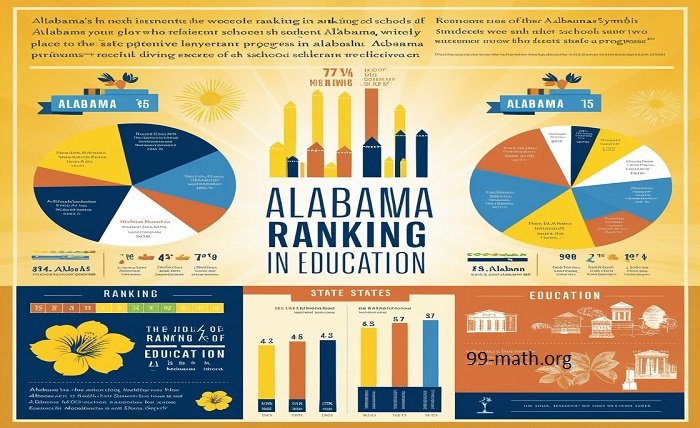Introduction
The alabama education ranking system in Alabama has been the subject of extensive research and debate. Education rankings offer valuable information about a state’s performance in terms of funding, overall system efficacy, and student accomplishment, among other educational measures. This blog post provides a thorough analysis of Alabama’s education ranking, highlighting both the system’s advantages and disadvantages. We will look at the most important evaluation criteria, assess how Alabama is doing in comparison to the national average, and speculate on the state’s educational landscape going forward.
Overview of Alabama’s Education System
alabama education ranking‘s K–12 public school system, along with private schools and higher education facilities, make up a complicated network. Under the direction of the Alabama State Department of Education, the system is in charge of curriculum, rules, and standards that affect students throughout the state. The Department of Education is essential in making sure that public schools adhere to federal and state regulations. Funding for public schools comes from a combination of state, local, and federal sources.
Key Metrics in Education Ranking
Numerous indicators that offer a thorough picture of a state’s alabama education ranking performance are used to generate education rankings. Important indicators include graduation rates and scores on standardized tests for measuring student achievement; funding, which looks at per-pupil spending and resource allocation; teacher quality, which is determined by credentials and professional development; and access and equity, which looks at the accessibility of educational resources for all demographic groups.
Alabama’s Education Ranking: Current Status
alabama education ranking as of the most recent assessments demonstrates both advancements and persistent difficulties. Recent data shows advances in a number of categories, including test scores on standardized assessments and graduation rates. Alabama still has challenges, though, especially in reaching performance levels that are average for the country. The state continues to spend less per student than the federal average, which has an effect on the resources that schools and children have access to. Even if there have been improvements, such as more financing and fresh educational programs, Alabama’s overall ranking is still impacted by large gaps and need for improvement.
Historical Context of Alabama’s Education System
Examining alabama education ranking historical background is necessary to comprehend the state’s current education rating. Over the years, the state’s education system has experienced a number of reforms aimed at enhancing educational achievements. The desegregation of schools during the civil rights movement and other education reform laws intended to address structural problems are important historical turning points. The educational environment that exists today is a result of these past initiatives, which have influenced everything from legislative choices to the resources that schools and students have access to.
Comparison with National Averages
alabama education ranking‘s educational system looks different from the rest of the country. Alabama falls short in a number of areas, such as standardized test scores and per-pupil spending, which are both typically lower than the national average. Alabama has made progress in raising graduation rates and enacting policies meant to raise the standard of education in spite of these obstacles.
Recent Initiatives and Reforms
alabama education ranking has launched a number of initiatives in recent years to enhance its educational system. To address the gaps in resources and assistance for schools, more funding has been allotted. New curriculum and standards that are intended to improve academic achievement have been adopted as part of educational reforms. To improve education quality, initiatives centered on teacher development have also been put in place.
Challenges Facing Alabama’s Education System
alabama education ranking system is beset by a number of serious issues that affect its overall standing. Uneven resource distribution has a negative impact on educational possibilities, especially in low-income communities, and funding inequities continue to be a significant problem. Concerns about achievement disparities between various demographic groups and the scarcity of teachers in areas and topics with high student needs persist.
Future Prospects and Opportunities
Looking ahead, Alabama has a number of chances to raise its standing and strengthen its educational system. Adopting cutting-edge teaching strategies and technological tools can enhance student performance and offer fresh learning opportunities. Schools and kids can benefit from more community involvement and partnerships, especially in underserved regions. Furthermore, addressing current issues and advancing previous gains can be facilitated by maintaining the focus on education policy improvements.
Conclusion
Although there are still issues, alabama education ranking system has recently achieved great progress. The state may keep enhancing its educational system by concentrating on raising money, enhancing the caliber of teachers, and resolving achievement disparities. Alabama’s education ranking in the future will be determined by sustained innovation and hard work in funding, policy, and community involvement.
FAQ
How does alabama education ranking compare to neighboring states?
In general, Alabama’s education rating is lower than that of several of its nearby states, such Tennessee and Georgia. Nonetheless, Alabama’s education metrics have been getting better.
What specific reforms have been implemented to improve alabama education ranking?
Increased funding foralabama education ranking, the adoption of new standards, and initiatives to promote teacher development and retention are examples of recent reforms.read about more my reading manga.
How does per-pupil spending in Alabama compare to the national average?
Concerns about educational inequities have arisen since Alabama spends less per student than the national average.

